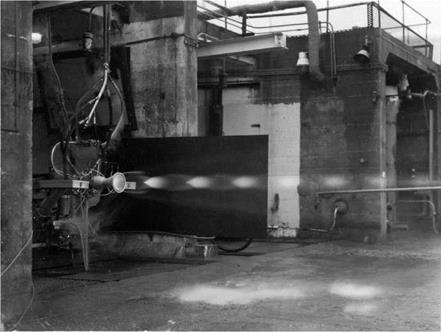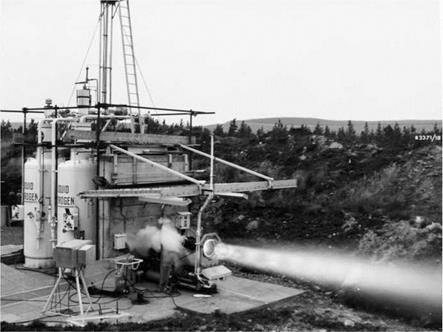Hydrogen
Liquid hydrogen is usually regarded as the most effective fuel for rockets. (In this section, it may be assumed that liquid oxygen is the oxidant. Fluorine is better theoretically, but is very hazardous environmentally, if from no other point of view.) This is because it has a very high exhaust velocity, or looking at it another way, a very high S. I. Thus the HTP/kerosene combination used in Black Knight and Black Arrow has an exhaust velocity in vacuum of around 2,500 m/s, whereas a well-designed liquid hydrogen motor can achieve exhaust velocities of around 4,400 m/s.
Using the rocket equation vfinal = vexhaust x ln(mass ratio), a liquid hydrogen stage of the same mass ratio would achieve a final velocity around 75% greater. On the other hand, the structural penalties of using liquid hydrogen means that the mass ratio would be significantly lower than an equivalent HTP stage. There are complications to liquid hydrogen vehicle design.
The first is that it is extremely cold boiling at -253 °C (20 K), and the second is that it has a very low density – 70 kg/m3 as opposed to around 1,300 kg/m3 for HTP.
The very low temperature of the liquid means the tank has to be well insulated, not only on the ground, but also from the heating effect of air friction
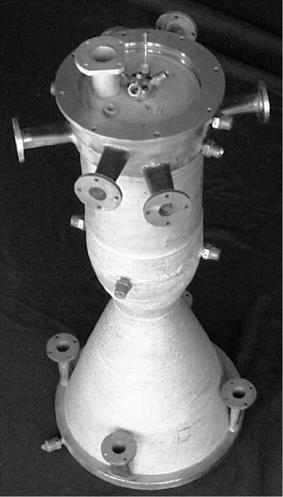 during launch. Although effective insulation is
during launch. Although effective insulation is
extremely light, this still adds weight to the vehicle. The low density means a large tank volume (almost 20 times that of HTP!), which again means extra weight.
Despite these drawbacks, liquid hydrogen is being used in an increasing number of vehicles, usually as an upper stage. The Ariane 5 central core uses liquid hydrogen, although it has the two large strap on solid fuel boosters to lift it to altitude. The Ariane 5 ECA (Evolution Cryotechnique type A) core has a burn time of 650 seconds.
RPE began work on hydrogen chambers in the late 1950s. At that time, they had no facilities for storing or producing liquid hydrogen, but instead used gaseous hydrogen pre-cooled by liquid nitrogen. A number of fully working Figure 13. A hydrogen/oxygen test chamber built chambers were built and fired at RPE Westcott. at Westcott (see Figure 14).
The larger chambers were capable of around 4,000 lb thrust: it would have been relatively easy to scale them up to, say, 8,000 lb, which would be well – suited to upper stages for Blue Streak, Black Knight, or Black Arrow. Such stages would have increased payloads very considerably. Whilst developing the chambers would not have been difficult, building a liquid hydrogen stage would have needed a considerable amount of development work and thus cost.
Based on this work, a variety of designs for launchers using Black Knight as the first stage were drawn up5. Some were pressure fed, others used turbopumps. Sketches of the designs can be seen below.
Calculations were carried out for a variety of configurations. Four different first stages were considered and three different second stages. A Cuckoo solid fuel motor was taken as third stage (calculations were also carried out for a two – stage version, without the Cuckoo motor, but only two of the combinations were able to put any payload into orbit at all). Payloads could no doubt be increased somewhat by a purpose-built third stage.
|
Figure 14. A hydrogen/oxygen chamber being test fired at the RPE, Westcott. |
 |
 |
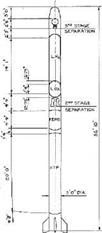 |
 |
![]()
FIG. I GENERAL ARRANGEMENTS OF VEHICLES HAVING PUMP FED SECOND STAGE.
Figure 15. Various proposals for satellite launchers using Black Knight as the first stage and a liquid hydrogen/oxygen second stage.
Version 1 is the standard Black Knight, with a tank diameter of 3 ft and a sea – level thrust of 21,600 lb. Versions 2, 3 and 4 have a tank diameter of 4 ft 6 inches and sea-level thrusts of 25,000, 40,000 and 50,000 lb respectively. Version 3 would have a six chamber motor, and version 4 an eight chamber motor (effectively the first stage of Black Arrow). The lift-off weight was derived by assuming a thrust : mass ratio of 1.25.
Three variants of the second stage engine and propellant feed systems were examined:
(a) An engine having four chambers w ith turbo-pump feed of the propellants.
(b) An engine having four chambers with pressurised tank feed.
(c) A single chambered engine with pressurised tank feed.
|
The estimated payloads for each variant was calculated as being:
|
Versions 1 and 2 are really non-starters. Versions 3 and 4 are, on the face of it, fairly promising. However, the first stage of version 4 is in effect Black Arrow. Developing Black Arrow, where the intention was to keep the cost down by using as much Black Knight technology as possible, stretched the budget. Developing a liquid hydrogen stage, which would have been technically challenging, would have been much more expensive, and, as can be seen, payloads were not very significant. Some improvement could have been achieved with solid fuel strap-on Raven boosters, but not enough to make the design worthwhile.
Another major proposal was for a liquid hydrogen third stage for the Blue Streak satellite launcher and the Anglo-French launcher proposal. Although the Saunders Roe brochure for Black Prince is sometimes taken as the ‘definitive’ version of the Blue Streak launcher, there was, in reality, no such thing. Black Prince shows an HTP third stage, but the RAE realised that a liquid hydrogen stage could increase the payload considerably, and in this period, it was looking at 6- or 12-hour orbits for communications satellites. It is interesting to see the emphasis that this stage is given in the initial brochure for the Anglo-French launcher.
Two quite comprehensive studies were carried out: one by the RPE and one by Saunders Roe. Both go into considerable detail, including detailed analysis of the thermal cladding that would be needed for the liquid hydrogen tank.
The RPE produced the report for its design in April 1961.6 One of the more unusual features of the report is that it seems to be the only one written in this period (other than some ELDO reports) which uses entirely metric units. This leads to some slightly awkward conversions. For example, the diameter of the fuel tanks is 1.37 m… or 54 inches! This was obviously designed as a third stage for a Blue Streak/Black Knight combination. Indeed, the RAE had calculated the optimum mass for a liquid hydrogen third stage for the Blue Streak launcher to
be 2,270 kg, and the stage was designed around this weight, although later calculations showed the optimum mass as 3,630 kg.
There would be four motors in the stage, each of which was intended to produce a thrust of 9 kN (2,000 lb) with a chamber pressure of 50 N/cm2 (5 bar or 75 psi). One design being considered was what might be described as self- pressurising: a pressure-fed system, with the gases being used to pressurise the tanks coming from the fuel itself via a heat exchanger. The tank pressures could be relatively low given the low chamber pressure – 80 N/cm2 (8 bar or 90 psi)
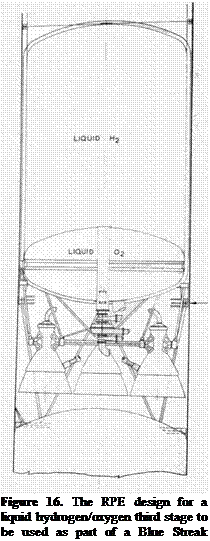 was the value being considered. This is quite an elegant solution, dispensing with the weight and complexity of a turbopump, yet avoiding the weight penalties of thicker tank walls and heavy gas bottles. The only drawback is that with the relatively low thrust, the burn time will be quite prolonged, which means carrying the unburned fuel up the Earth’s gravitational potential well as the vehicle gains in height.
was the value being considered. This is quite an elegant solution, dispensing with the weight and complexity of a turbopump, yet avoiding the weight penalties of thicker tank walls and heavy gas bottles. The only drawback is that with the relatively low thrust, the burn time will be quite prolonged, which means carrying the unburned fuel up the Earth’s gravitational potential well as the vehicle gains in height.
The specification for the BSSLV third stage investigated by Saunders Roe required a motor which had:
(a) A thrust of between 3000lb and 4000lb (in vacuo) lasting for about 15 to 20 minutes.
(b) A thrust of between 40lb and 60lb (in vacuo) lasting for about 2Vi to 3Vi hours.
Communication satellites need to be in as high an orbit as possible, and the new vehicle could have put an appreciable payload in an orbit around 8,000 miles high. The usual method of doing this is the apogee motor, as discussed before. Bristol Siddeley came up with a design for a motor which used a motor with two large chambers and two small chambers. The large chambers would take the vehicle up to orbital height, but the small chambers would then be used to raise the orbit, with a
burn time of two or three hours.
 To power such low thrust chambers with a pump was impractical. Pressurising the tanks usually meant carrying large and heavy gas bottles. Instead, the proposal was to use a heat exchanger to produce ‘hot’ (relative in this context) hydrogen gas. The gas could then be used to pressurise the tanks (a further heat exchanger would be needed for the liquid oxygen tank).
To power such low thrust chambers with a pump was impractical. Pressurising the tanks usually meant carrying large and heavy gas bottles. Instead, the proposal was to use a heat exchanger to produce ‘hot’ (relative in this context) hydrogen gas. The gas could then be used to pressurise the tanks (a further heat exchanger would be needed for the liquid oxygen tank).
Rocket chambers are usually at quite high pressures – perhaps 40 times atmospheric pressure. At sea level, the escaping gases are opposed by atmospheric pressure, and higher chamber pressures make the motor more efficient. In the vacuum of space this does not apply. Chambers can be run at quite low pressures, and it was suggested in this case that a chamber pressure of only one atmosphere might well be feasible. This avoids the complication of pumps and the weight of gas bottles.
On the other hand, pumps are needed for the earlier boost phase, and unless they are discarded (which they were not), the vehicle is carrying unnecessary weight during the long cruise phase.
 |
Bristol Siddeley had not done any work on liquid hydrogen motors up to now, and this proposal was marked in the Ministry of Supply file with a hand written comment:
Downey thinks we would be nuts to bring yet another firm into the space business.7
Downey was one of the senior officials in the Ministry of Aviation – the criticism is slightly unfair since Bristol Siddeley were already producing the Gamma motors for Black Knight.
Saunders Roe were given the task of designing the tank structure, and produced a substantial brochure8. In conjunction with RAE and Bristol Siddeley Engines, the parameters for the design were set:
7.0  lb approximately
lb approximately
5.0 lb approximately 400 lb. sec/lb
Two thrust phases:
(1) Boost: 3,500 lb for 8 minutes
(2) Cruise: 44 lb for 2 hours
It was estimated that such a design could put 900 lb in a 5,000 mile circular orbit or 600 lb into a 9,000 mile orbit.
 |
In many ways this is an interesting idea, but on closer inspection has as many drawbacks as advantages. During the cruise phase, the large chambers and their plumbing are still attached to the vehicle, but as dead weight. Jettisoning them would make the proposal much more efficient but would not be easy. Secondly, a ‘slow burn’ is less efficient from a different point of view: as the vehicle climbs the gravity well as it moves further from the Earth, then it is taking unused fuel with it. From a gravitational potential energy point of view, it is better to expend the fuel in one big burst at the start of the orbit transfer – this does the opposite!
In the end, of course, all of this became moot. The third stage of Europa was to be developed by Germany, and the design chosen was very different. As a consequence of the ELDO B proposals put forward by the French in 1964, contracts were awarded for research into liquid hydrogen motors. Rolls Royce was one of the firms involved, and building on the work done at the RPE, began the design and testing of a motor called the RZ 20. The contract was shared with the French firm of SEPR (Societe d’Etudes pour la Propulsion par Reaction). Rolls Royce was to produce the thrust chamber part of the motor, with SEPR providing the turbopump assembly.
Val Cleaver, Chief Engineer of the Rocket department at Rolls Royce, wrote to the Ministry of Technology asking whether he could build the test stand at Spadeadam, which was a Ministry establishment, but being run as an agency by Rolls Royce.
JEP Dunning, Director of the RPE, protested that the test site should be built at Westcott, which already had extensive facilities for testing and firing liquid hydrogen chambers, although none of them had been as powerful as the proposed Rolls Royce chamber, seen below being test fired at Spadeadam (Figure 19). Cleaver pointed out that Rolls Royce were building the facility as a private venture. As he put it in a letter to the Ministry of Technology:
It was not possible for ELDO to commit any money for the necessary test facilities for these chambers. Therefore (and not without some difficulty, as you can probably imagine) I persuaded our Main Board to sanction the cost of a modest test cell for the purpose, as a P. V. Extension to the Components Test Area at Spadeadam.9
He went on to say:
We are most anxious to have the test facility at Spadeadam, for two very definite reasons:-
(a) Because if any larger operational programmes for hydrogen rocketry ever arise in the UK, it will be inevitable that their testing should be done at Spadeadam. It is highly desirable, therefore, to begin as we mean to go on, and start gaining early experience there as soon as possible.
(b) Because the team at Spadeadam desperately need some injection of new work, to raise morale and inspire some confidence in the future of the establishment (I am sure I do not need to emphasise to you the problems of this sort we have had since 1959, with the 1960 military cancellation and all ELDO’s subsequent ups and downs.)
|
Figure 19. Rolls Royce RZ 20 hydrogen motor being test fired at Spadeadam. |
Given that it was a private venture, the costs were substantial: £54,000 for the construction costs, £15,000 for two liquid hydrogen road trailers, and £5,000 for the chamber itself, making a total of £74,000 (a contingency figure of approximately 10% was added to the estimate to bring it up to £81,000).
In the end, two firings, each of ten seconds duration, were achieved before the programme ran out of money. The total cost of the programme was £250,000.











